The key differences between yak and musk ox lie in their habitat, physical characteristics, and social behavior.
Yaks, native to the Himalayan region, possess long, thick hair and large horns that curve outward. Conversely, musk oxen, native to Arctic tundra, are easy to spot with their warm ‘qiviut’ coat and huge horns that hang down and then curve up around their faces.
As members of the Bovid family, they may share common characteristics. But they differ quite a bit in their environmental adaptations, social behaviors, and reproduction methods.
Did you know that yaks are pretty friendly with people because they’ve been tamed over time? Musk oxen, however, like to stay wild and free.
Intrigued yet? That’s just a peek into the world of yaks and musk oxen! Keep reading this blog to uncover the differences between these intriguing creatures. There’s so much more to discover!
Yak Vs Musk Ox – A Quick Comparison Table
Let’s take a quick look at the differences between these two creatures.
| Feature | Yak | Musk Oxen |
| Scientific name | Bos grunniens | Ovibos moschatus |
| Body Shape | Large, long-haired, humpless | Smaller, stocky, rounded body |
| Horns | Long, curved horns | Short, curved horns that droop down and curve up |
| Coat | Dense, shaggy fur | Thick, long woolly coat known as ‘qiviut.’ |
| Size | Up to 11 feet long, weighing up to 1000 kg | Up to 8.5 feet long, weighing up to 450 kg |
| Diet | Grass, herbs, and shrubs | Arctic plants and mosses |
| Habitat | Mountainous regions of Asia | Arctic tundra and mountain regions |
| Social Behavior | Semi-domesticated or wild, often in groups | Form large herds, display group defense mechanisms |
| Lifespan | 20-25 years in the wild | Almost 20 years in the wild |
| Gestation period | About 9 months, usually a single calf born | About 8.5 months, a single calf born |
| Conservation status | Domesticated population is not threatened, wild yaks are Vulnerable | Least concern |

Yak Vs Musk Ox – What Are the Key Differences?
Yaks and musk oxen may look similar at first glance but exhibit numerous distinctions. Let’s walk through the vast expanse of the Himalayas and Arctic tundra to discover who’s who in the world of these terrestrial giants.
1. Yak Vs Musk Ox: Taxonomy and Classification
Both the yak and musk ox are part of the mammalian order Artiodactyla, which comprises even-toed ungulates. However, their taxonomic classification diverges from there.
Yak
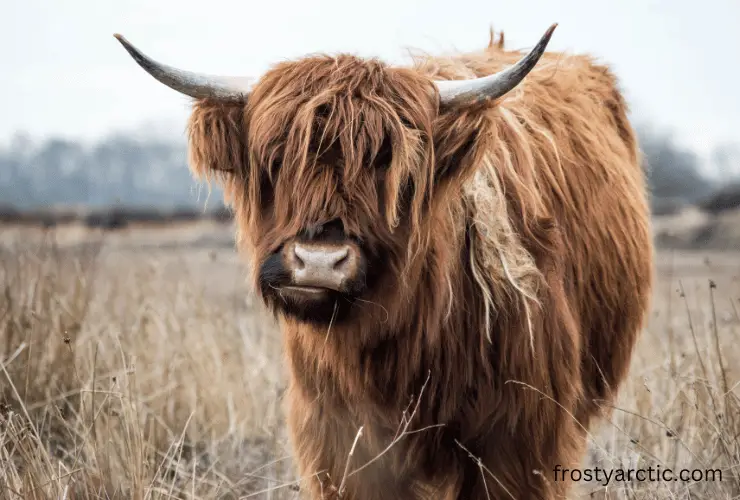
Yaks belong to the Bovidae family, like musk oxen. However, their sub-family is Bovinae, categorized under the Bos genus. The wild yak is scientifically known as Bos grunniens, and the domestic yak is called Bos mutus.
According to an article published in Sustainability, these impressive creatures first appeared around 2.5 million years ago in the Qinghai-Tibetan Plateau. They are the embodiment of high-altitude regions in Asia and were first domesticated around 4,500 years ago.
Also Read: Bison vs Musk Ox: Key Differences Explained with Photos
Domestic yaks fall into the subspecies Bos grunniens grunniens, while the wild yaks are classified as Bos grunniens mutus.
Musk Ox
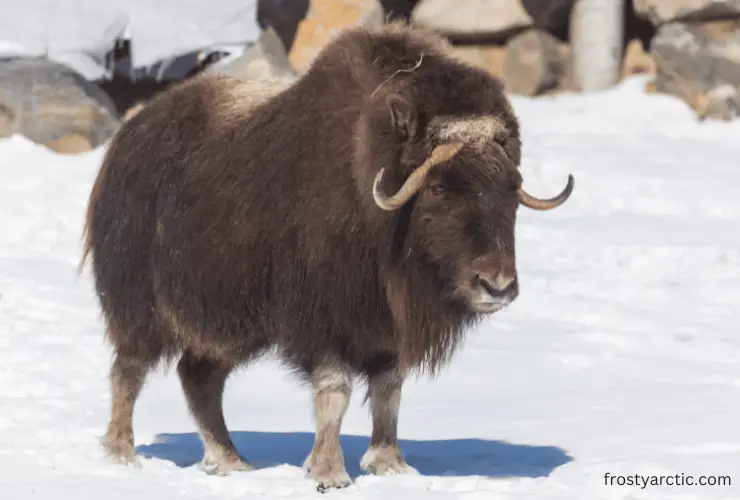
Musk oxen are also a part of the Bovidae family but belong to the sub-family Antilopinae and the Ovibos genus. Musk oxen are scientifically known as Ovibos moschatus. Adapted to harsh arctic conditions, musk oxen first appeared approximately 129,000 years ago.
| Taxonomic Rank | Yak | Musk Ox |
| Kingdom | Animalia | Animalia |
| Phylum | Chordata | Chordata |
| Class | Mammalia | Mammalia |
| Order | Artiodactyla | Artiodactyla |
| Family | Bovidae | Bovidae |
| Subfamily | Bovinae | Antilopinae |
| Genus | Bos | Ovibos |
| Species | grunniens | moschatus |
| Subspecies | grunniens (domestic), mutus (wild) | N/A |
2. Yak Vs Musk Ox: Habitat and Distribution
Yaks and musk oxen reside in strikingly different regions globally, each having evolved unique adaptations suitable for their specific environments.
Yak
According to the Encyclopedia of Animal Science, yaks are native to the Himalayan region of South Asia, Mongolia, and Russia. The species is particularly adapted to high altitudes, often found at heights above 3,000 meters, where the air is thin, and temperatures often drop below freezing.
Domestic yaks are widespread across the Himalayan region, including Tibet, Nepal, India, and Bhutan. In contrast, wild yaks predominantly inhabit remote areas of the Qinghai-Tibetan Plateau in China.
Musk Ox
The Handbook of Natural Fibres (Second Edition) details that musk ox is native to the Arctic regions of North America, Siberia, and Greenland. This species thrives in frigid environments, enduring temperatures that can reach -40 degrees Celsius.
While musk oxen were previously extinct in Alaska around the late 19th century, reintroduction programs have succeeded. Musk oxen now inhabit areas of northern Alaska, Canada, and Greenland, and there are introduced populations in parts of Scandinavia and Russia.
| Yak | Musk Ox | |
| Habitat | High-altitude grasslands, alpine meadows, and plateaus | Arctic tundra |
| Distribution | Tibet, Nepal, India, Bhutan, Mongolia, Russia, and Qinghai-Tibet in China | Greenland, Siberia, northern Alaska, Canada, parts of Scandinavia, and Russia |
3. Yak Vs Musk Ox: Physical Appearance
Both yaks and musk oxen present distinct physical features shaped by their specific habitats.
Yak
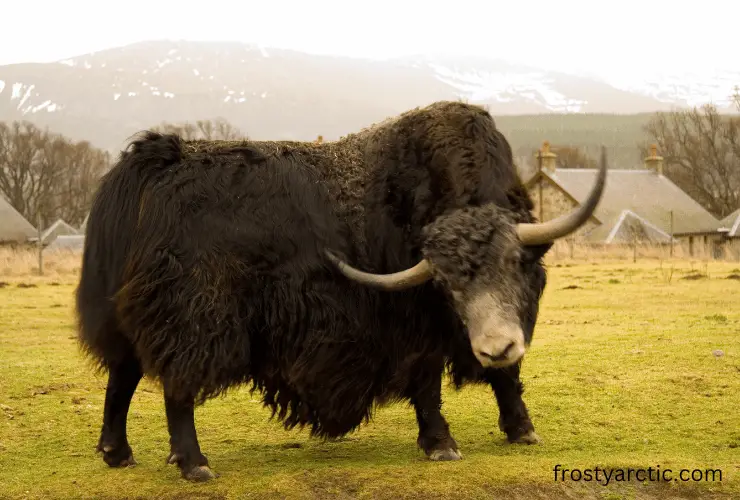
Yaks, as detailed in the Animal Diversity Web, are large bovines. Adults can reach heights of up to 2 meters at the shoulder, weighing up to 1,800 pounds, and females up to 600 pounds. They have a robust body, rounded at the edges, and a long bushy tail.
Both male and female yaks possess long, curved horns that extend out from the sides of the head. The horns of a yak can reach lengths of up to 80 cm in males and 50 cm in females.
Their coat consists of long hair that often reaches the ground and forms a skirt around the animal. The color ranges from dark brown to black, though white yaks are also known.
Did you know that yaks have a dense undercoat that allows them to endure temperatures as low as -40 degrees Celsius?
Musk Ox
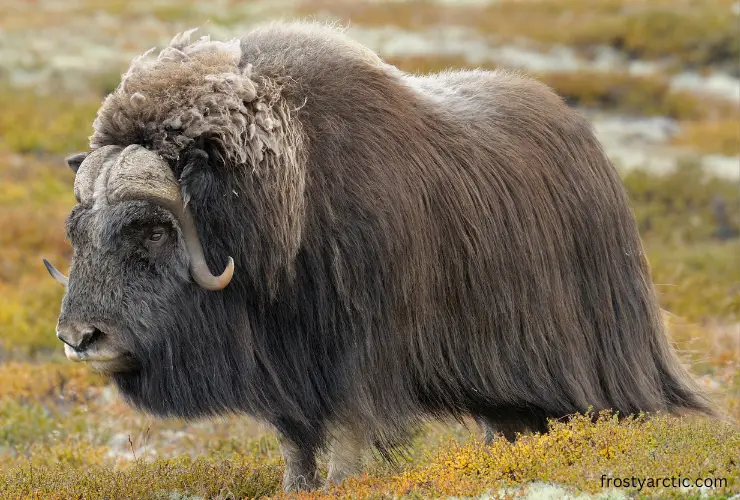
According to the Alaska Department of Fish and Game, musk oxen stand 4 to 5 feet at the shoulder weighing almost 900 pounds. They have a stocky build with a large, rounded body and short legs, well-suited for conserving heat in the Arctic chill.
Both sexes have large, curved horns that sweep down from the forehead. The horns can reach lengths of around 61 cm.
The musk ox’s coat is designed for extreme cold. It consists of two layers: a long, shaggy outer coat (guard hair) and a dense, soft underwool (qiviut), reputed to be one of the warmest wools in the world.
| Physical Features | Yak | Musk Ox |
| Size | Up to 7.5 feet tall | 4-5 feet tall |
| Weight | Up to 1,300 pounds | Up to 900 pounds |
| Horns | Long, curved, up to 80 cm | Large, curved, up to 61 cm |
| Coat | Long hair, dark brown to black | Guard hair and qiviut, dark brown |
4. Yak Vs Musk Ox: Diet and Feeding Habits
Both yaks and musk oxen are herbivorous species, but their diets and feeding habits are shaped by the different plants available in their respective habitats.
Yak
Yaks, according to a study in Frontiers in Veterinary Science, are predominantly grazers, with their diet mainly composed of:
- Grass
- Lichens
- Moss
- Herbs and Shrubs
- Sedges, including Carex, Stipa, and Kobresia
Their long, prehensile tongue enables them to pull and grasp tufts of vegetation quickly.
When their alpine habitats are covered in snow in winter, yaks dig through the snow layer using their horns to reach the vegetation beneath.
Musk Ox
Musk oxen, according to research by the University of Saskatchewan, have a diverse diet to sustain themselves in the harsh Arctic environment, which includes:
- Grasses
- Forbs
- Sedges
- Lichens
- Mosses
- Woody plants such as willow, birch, and other dwarf shrubs
During the winter, musk oxen employ a technique known as “cratering” to feed. They use their strong hooves to break through the icy snow and reach the lichens and mosses beneath, providing essential nutrition during the lean Arctic winters.
| Yak | Musk Ox | |
| Diet | Grass, lichens, moss, herbs, shrubs, sedges | Grasses, forbs, sedges, lichens, mosses, and dwarf woody plants |
| Feeding Habits | Use prehensile tongue to grasp vegetation, horns to dig through snow in winter | Use robust hooves to break through icy snow to reach food in winter |
5. Yak Vs Musk Ox: Social Behavior
Both yaks and musk oxen are social animals exhibiting exciting group dynamics and behaviors.
Yak
As detailed in Animals: An Open Access Journal from MDPI, yaks typically live in herds ranging from 50–60 animals. The herd usually comprises females and their offspring. Outside the mating season, the male yaks often form smaller bachelor groups or live in isolation.
During the mating season, the males join the female groups, displaying aggressive and dominant behaviors to secure mating rights with the females. Post-mating, they return to their solitary or bachelor group existence.
Musk Ox
As reported by the Alaska Department of Fish and Game, musk oxen form herds ranging from a few animals to as many as 75. The typical group comprises adult females, their offspring, and a dominant male.
Mature bulls are often solitary or form small all-male groups, except during the mating season when they seek out and join female groups.
During the harsh winter months, musk oxen form larger, mixed-sex herds, which is unusual among hoofed animals. This adaptation is believed to be a survival strategy against predators and the extreme Arctic weather.
| Yak | Musk Ox | |
| Social Structure | Herds range from 50 to 60 animals | Herds range from a few animals to as many as 75 |
| Mating Behavior | During the mating season, the males join the female groups; they return to their solitary or bachelor group existence post-mating. | Mature males seek out female groups during mating season and join mixed-sex herds in winter. |
6. Yak Vs Musk Ox: Reproduction and Lifecycle
The reproduction and lifecycle patterns of yaks and musk oxen are relatively similar. However, their specific breeding seasons, gestation periods, and lifespans differ.
Yak
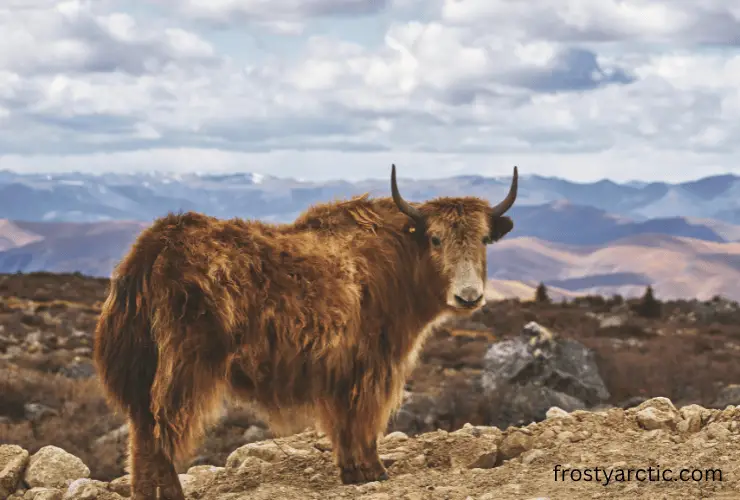
Yaks typically have a breeding season from September to October. Domestic yaks reach sexual maturity at around 3-4 years for females and 6-8 years for males.
The gestation period for yaks is approximately 9 months, and they typically give birth to a single calf, typically from May to June, as detailed in an article published in Theriogenology.
In the wild, yaks can live up to 20 years. But in domestic conditions, where they’re protected from predators and harsh weather, they can live up to 25 years.
Musk Ox
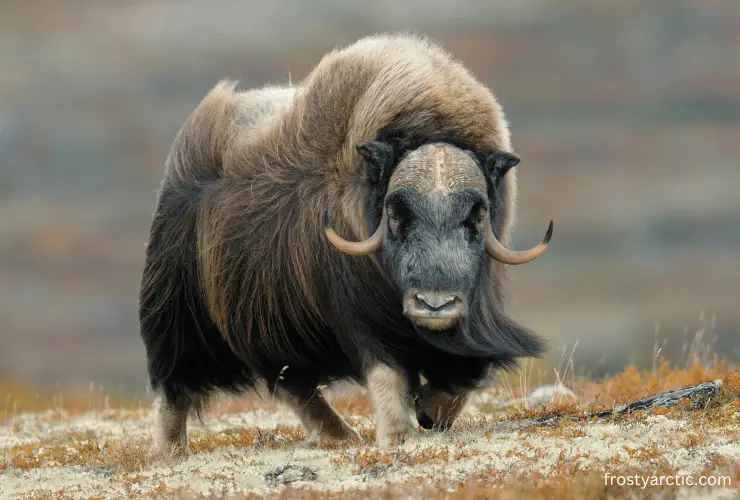
Musk oxen have a breeding season from July to October. They reach sexual maturity at around 2 years for females and 5 years for males, as detailed in an article published in Bioscientifica.
The gestation period for musk oxen is approximately 8-9 months, and they typically give birth to a single calf from April to June. They live approximately 12 to 20 years in the wild.
| Reproduction | Yak | Musk Ox |
| Breeding Season | September to October | July to October |
| Age at Maturity | 3-4 years for females; 6-8 years for males | 2 years for females; 5 years for males |
| Gestation Period | Approximately 9 months | Approximately 8-9 months |
| Offspring | Single calf | Single calf |
| Lifespan | Up to 20 years in the wild, 25 years in captivity | Approximately 12 to 20 years in the wild |
7. Yak Vs Musk Ox: Natural Predators
Both yaks and musk oxen are large mammals that are well-equipped to defend against predators due to their size, strength, and herd behavior. However, predators specific to their geographical habitats differ.
Yak
Yaks, due to their high-altitude habitat in the mountainous regions of Central Asia, have a smaller range of natural predators than many other large mammals.
The main predators of yaks, particularly calves and weak or old adults, are snow leopards and wolves. Additionally, brown and Tibetan blue bears have also been known to prey on yaks occasionally.
Musk Ox
In the harsh Arctic conditions of their native habitats, musk oxen face threats from a range of predators. The primary predator of musk oxen is the Arctic wolf.
In addition to wolves, other potential predators include grizzly bears and polar bears. Wolverines can also pose a threat, particularly to young or weak individuals.
| Species | Natural Predators |
| Bison | Wolves, Brown Bears, Tibetan Blue Bears, Snow Leopards |
| Musk Ox | Wolves, Brown Bears , Grizzly bears, Polar Bears, Wolverines |
8. Yak Vs Musk Ox: Defense Mechanism
Both yaks and musk oxen have evolved specific defense mechanisms tailored to their respective environments and predator threats.
Yak
Yaks live in large groups, sometimes numbering over 100, and these groups protect them from attacks by wild predators. The yaks look out for each other, ensuring they are always nearby while grazing, as detailed in research conducted by FAO.
In the event of a threat, the yaks will form a protective circle around the younger, weaker individuals, presenting a formidable front of horns and large bodies to the predator. Their thick coat also offers some protection against bites or scratches.
However, they can get quite scared if they are suddenly ambushed while relaxing and not ready for danger. If this happens, a yak might run away from the group and could become a target for wild animals.
They might lose their footing if they get scared while on a hill, maybe by human activity or the sounds of wild creatures. They could tumble down the slope; unfortunately, such a fall could be fatal.
Musk Ox
Musk oxen also adopt a defensive strategy that involves forming a circle around the young and weak individuals of the herd when threatened by a predator. This strategy is particularly effective against wolves, their primary predators.
In addition to this group strategy, individual musk oxen also have physical attributes that aid their defense. Their sharp, curved horns and thick double-layered coat protect against predators. Musk oxen can also exhibit aggressive behavior, such as charging when threatened.
| Defense Mechanism | Yak | Musk Ox |
| Herd Behavior | Form a protective circle around the young and weak during a threat. | Form a protective circle around the young and weak when threatened. |
| Physical Attributes | Have large bodies and long horns; thick coats protect against bites or scratches. | Possess sharp, curved horns and a thick, double-layered coat that protects against predators. |
| Reaction to Threats | May run away when ambushed or scared, potentially falling prey to predators or suffering fatal falls. | May exhibit aggressive behavior, such as charging when threatened. |
9. Yak Vs Musk Ox: Interactions with Humans
Both yaks and musk oxen have long histories of interaction with humans, serving different roles in various cultures due to their unique adaptations and characteristics.
Yak
Humans have domesticated and used yaks for over a thousand years in the high-altitude regions of Central Asia, particularly in Tibet and Mongolia.
Did you know? Yak is known as ‘the ship of cold regions.’ As detailed in the Encyclopedia of Dairy Sciences (Second Edition), it caters to various requirements such as providing food, textiles, transport, dairy, and meat to those living in cold mountainous areas.
Musk Ox
Musk oxen have a different kind of interaction with humans. As stated in the Wildlife Biologue, they have been hunted for their meat and hides by Arctic people for thousands of years.
In recent times, the soft underwool of the musk ox, known as qiviut, has become highly prized. Qiviut is softer than cashmere and is used to make luxury knitwear.
Conservation efforts in some areas have also led to an increase in musk ox tourism. Viewing these magnificent creatures in their natural environment has become a popular tourist attraction in places like Alaska.
However, due to their shy nature and the remote, harsh environment, musk oxen have never been domesticated to the extent that yaks have been.
| Species | Interaction with Humans |
| Yak | Used for transport, dairy, meat, wool, and fuel in high-altitude regions |
| Musk Oxen | Hunted for meat and hides; underwool used in luxury knitwear; species tourism |
10. Yak Vs Musk Ox: Threats and Conservation Status
Yaks and musk oxen face numerous threats, primarily from human activities and climate change. However, their conservation statuses differ significantly.
Yak
As reported in the IUCN Red List, the wild yak is listed as ‘Vulnerable’ due to habitat loss, illegal hunting, and hybridization with domestic yaks.
On the other hand, domesticated yaks are not threatened and are common throughout the mountainous regions of Central Asia.
Musk Ox
Musk oxen have faced near extinction in the past. The population has recovered due to extensive conservation efforts. They are now listed as “Least Concern” on the IUCN Red List.
Conservation efforts for both yaks and musk oxen focus on protecting their habitats, enforcing hunting regulations, and monitoring population health and numbers.
| Species | Conservation Status |
| Yak | Wild yak: Vulnerable; Domestic yak: Not threatened |
| Musk Oxen | Least Concern |
FAQs
Is Yak a cow or buffalo?
A: A yak is neither a cow nor a buffalo. It is a distinct species within the Bovid family, closer to bison and buffaloes than domestic cattle.
What is another name for the musk ox?
A: Another common name for the musk ox is “Oomingmak,” which means “the bearded one” in the Inupiaq language spoken by the Alaskan Inuit.
Wrapping Up
So, are yaks and musk oxen the same? Far from it! Both belong to the Bovidae family, yet they come from different genera.
From the genus Bos, Yaks are renowned for their long, dense coats and formidable horns, designed for life in the harsh Himalayan environment. In contrast, musk oxen, hailing from the genus Ovibos, have adapted to the extreme Arctic conditions with their woolly ‘qiviut’ coats and unique horn structure.
Their common traits and differences create a captivating ‘spot-the-difference’ challenge in the animal kingdom! We trust you’ve enjoyed uncovering the intriguing contrasts between these extraordinary mountain and tundra dwellers!

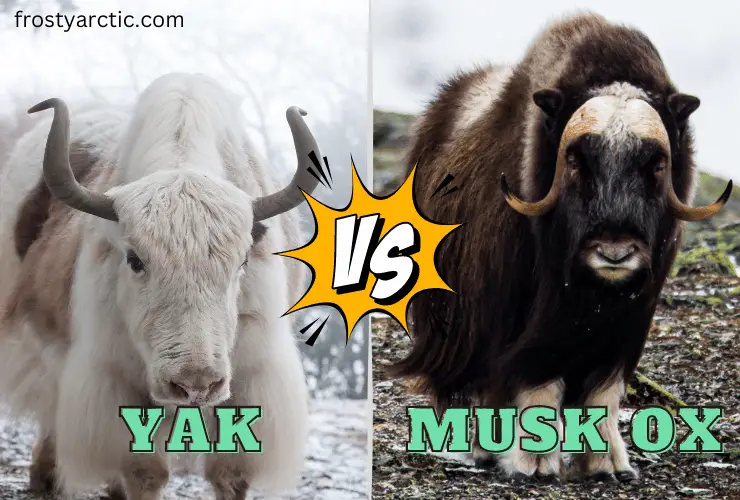

1 thought on “Yak vs Musk Ox: Key Differences Explained”